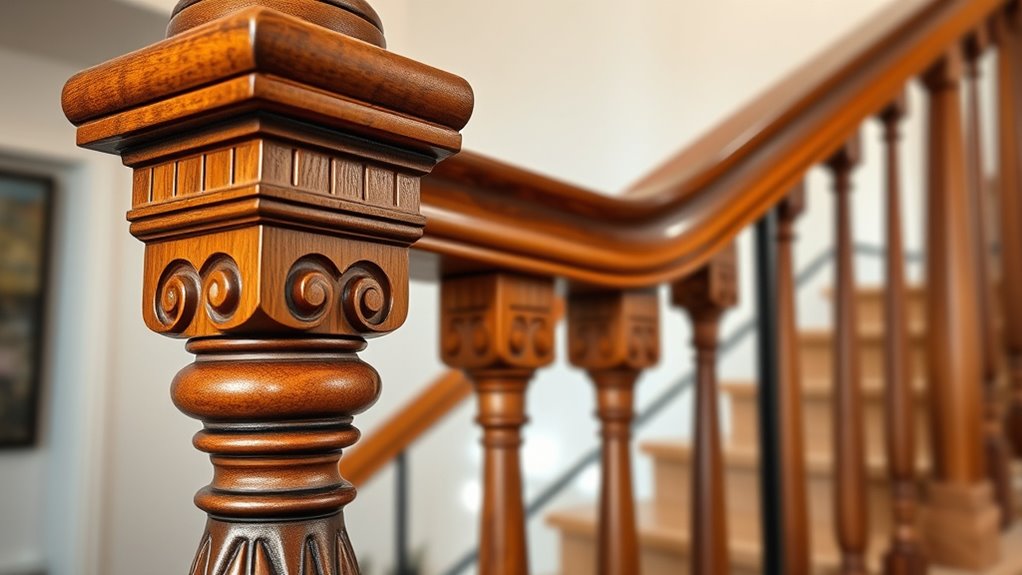Deciding whether to install your handrail yourself or hire a pro depends on your skills, tools, and knowledge of building codes. If you’re confident with measurements, drilling, and understand safety standards, a DIY project can save money and be rewarding. However, if you’re unsure about regulations, lack tools, or want a perfect finish, hiring a professional guarantees safety, durability, and compliance. Keep exploring to find the best approach for your project needs.
Key Takeaways
- Assess your carpentry skills and tool availability to determine if DIY is feasible and safe.
- Consider project complexity, such as staircase angles and safety code requirements, which may require professional expertise.
- Evaluate material quality and long-term durability needs; professionals ensure proper installation and compliance.
- Weigh potential cost savings of DIY against risks of mistakes, delays, or safety hazards requiring later repairs.
- For complex or code-critical projects, hiring a professional guarantees safety, durability, and adherence to regulations.
Assessing Your Skill Level and Tools
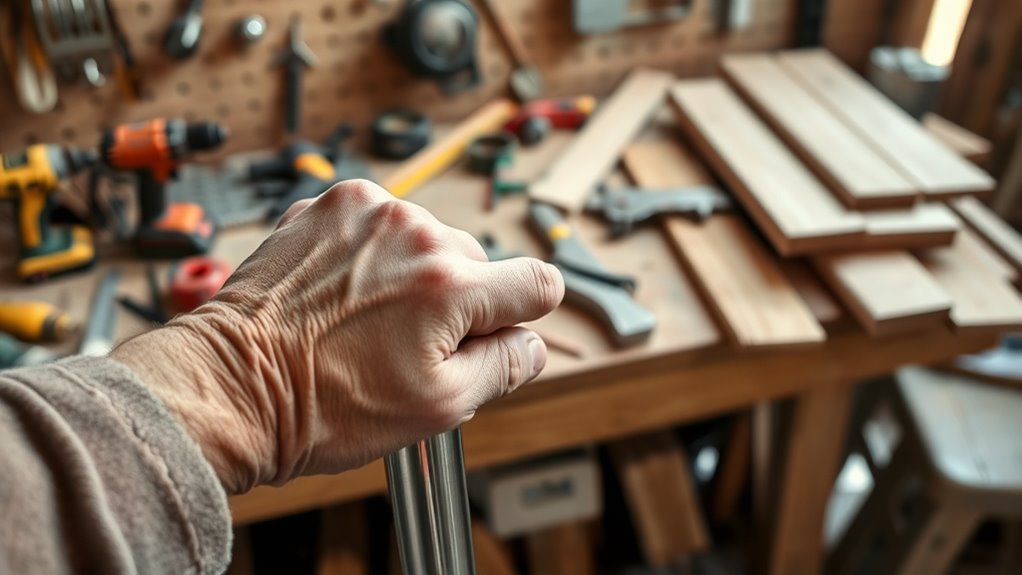
Before you begin installing a handrail, it’s important to honestly evaluate your skill level and the tools you have on hand. Skill assessment helps you determine whether you can handle the project or if professional help is needed. Be honest about your experience with carpentry, drilling, and measuring. Next, consider your tool selection—do you have a drill, level, screwdriver, and other necessary equipment? If you’re missing key tools, your project might stall or result in an unsafe installation. Starting with a clear understanding of your abilities prevents frustration and ensures safety. If your skill set or tools are limited, it’s worth considering whether to proceed or hire a pro. Proper tool selection and skill assessment are crucial first steps to a successful, secure handrail installation. Additionally, understanding the importance of authenticity and self-awareness in your project approach can lead to more realistic expectations and better outcomes.
Understanding Building Codes and Safety Regulations
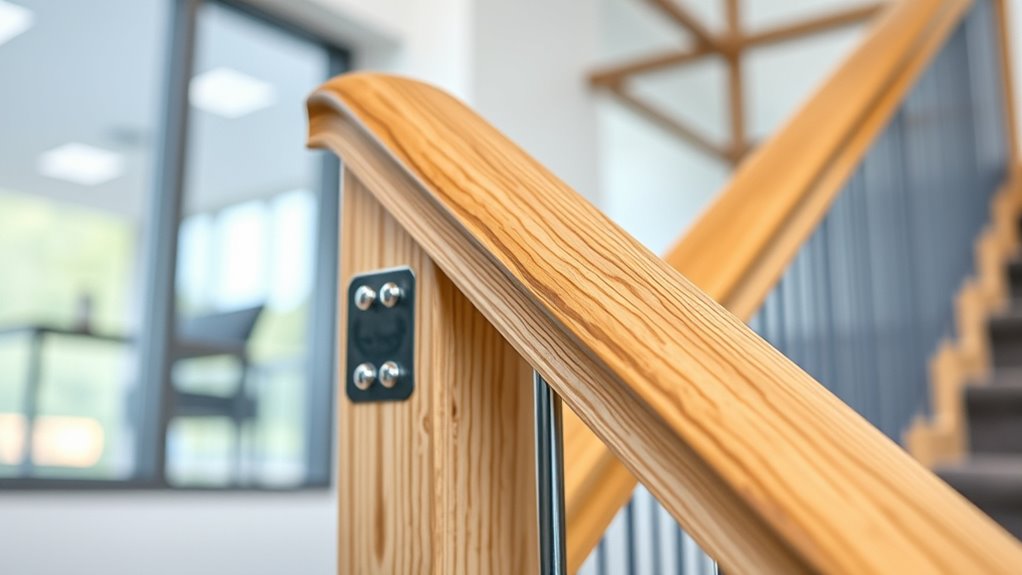
Understanding building codes and safety regulations is essential to guarantee your handrail installation complies with local laws and keeps everyone safe. These regulations often include specific requirements for height, spacing, and strength, especially in historic preservation areas where maintaining cultural integrity is vital. Ignoring codes can lead to safety hazards or legal issues. To navigate these rules effectively, research local building codes related to handrails and safety standards. Consider cultural considerations, like preserving historic features or adhering to community guidelines. Consult with professionals if you’re working in areas with strict historic preservation rules or unique regulations. Additionally, understanding AI Discoveries can inform innovative approaches to safety and compliance in construction projects.
Cost Analysis: DIY vs. Professional Installation
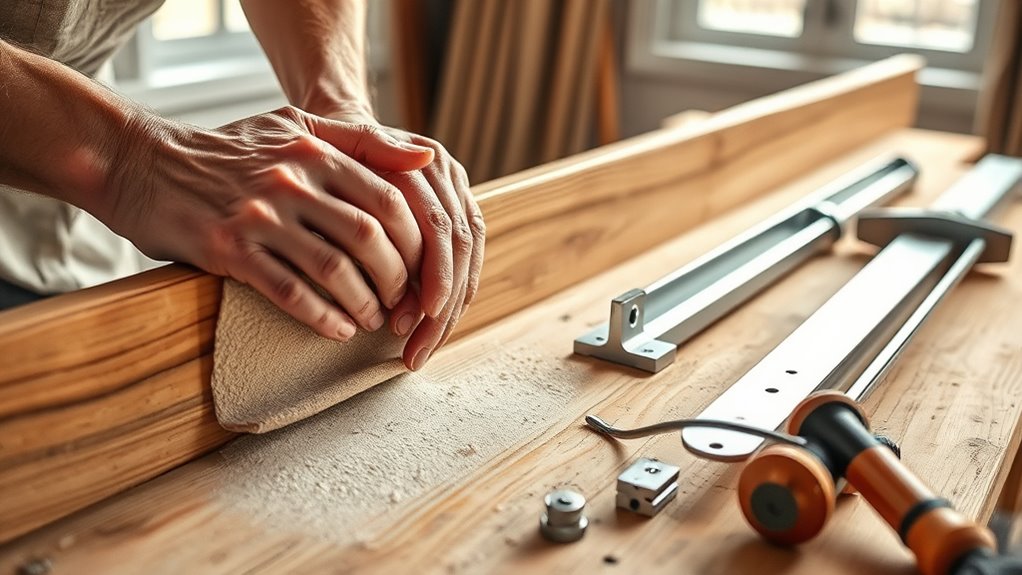
When comparing DIY and professional handrail installation, you’ll want to contemplate material costs and quality, which can vary widely. Labor and time expenses add up quickly if you’re doing it yourself, but hiring a pro often comes with higher upfront fees. Don’t forget to account for hidden or additional charges that might surprise you regardless of your choice. Additionally, understanding the benefits of using appropriate exfoliating acids like glycolic acid can help in preparing surfaces for better adhesion and finish.
Material and Quality Costs
Considering the materials and quality of your handrails can considerably impact your overall costs, whether you’re tackling the project yourself or hiring a professional. Your material selection influences durability, appearance, and price. A thorough quality comparison shows that higher-grade materials, like hardwoods or metal, tend to cost more upfront but last longer. Conversely, affordable options like PVC or pine may save money initially but could require replacement sooner. Additionally, the choice of cost-effective materials can vary based on the desired safety standards and aesthetic preferences.
Key points to consider:
- Premium materials increase upfront costs but reduce long-term expenses.
- Lower-quality materials might seem cheaper but can lead to additional replacements.
- The choice of material affects both safety and aesthetic appeal.
Balancing quality and budget ensures you get a sturdy, attractive handrail without overspending.
Labor and Time Expenses
Labor and time expenses can considerably influence the overall cost of installing handrails, whether you choose to do it yourself or hire a professional. When doing a cost comparison, you’ll find that DIY projects often save money on labor but require significant time investment. If you’re skilled and organized, you might complete the task quickly, but inexperience can lead to delays and rework, increasing the total time spent. Hiring a professional typically involves higher upfront costs, but they usually complete the job faster due to experience and proper tools. Effective time management is key—consider how much time you can realistically dedicate versus the potential for mistakes or delays. This balance can help you decide whether the savings of DIY outweigh the convenience and efficiency of professional installation. Additionally, understanding the divorce process and requirements can influence your planning, similar to how assessing skills and resources impacts a DIY project.
Hidden and Additional Fees
Hidden and additional fees can catch you off guard during handrail installation, especially if you’re not aware of all potential costs upfront. When comparing DIY and professional options, consider that hidden fees often arise unexpectedly. For example:
- Permit fees or inspection costs that aren’t included in quotes.
- Extra materials or hardware needed if measurements change.
- Unexpected labor charges if issues arise during installation.
These hidden fees and additional costs can substantially increase your total expense, making DIY less straightforward than it seems. Professionals often include these fees in their initial quote, but if you go it alone, you might face surprise charges later. Always ask for a detailed estimate and clarify what’s covered to avoid unexpected expenses. Being aware of these potential costs helps you make a more informed decision. Additionally, understanding security zone info can help you anticipate and avoid unforeseen costs associated with safety and security measures.
Step-by-Step Process for DIY Handrail Installation
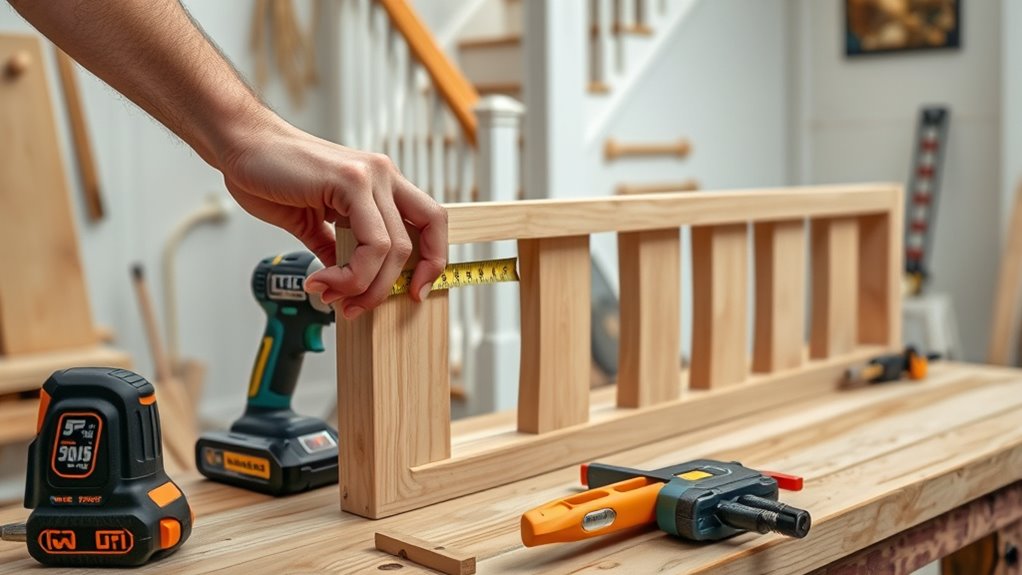
Installing a handrail yourself can be a straightforward project if you follow the right steps carefully. First, measure the staircase length and mark where the handrail will sit. Next, locate wall studs or mounting points for secure attachment. Cut the handrail to size, considering design aesthetics, and drill necessary holes. Use appropriate brackets and anchors to ensure stability. Always double-check measurements before drilling. Consider environmental impact by choosing sustainable materials when possible. Follow these steps:
| Step | Action | Tips |
|---|---|---|
| Measure & Mark | Determine placement and length | Keep consistent with staircase design aesthetics |
| Cut & Drill | Trim handrail, drill holes for brackets | Use eco-friendly materials if available |
| Mount & Secure | Attach brackets, install handrail securely | Check stability and levelness |
A crucial aspect to ensure the safety and durability of your handrail is proper attachment, which involves securely fastening brackets into wall studs or appropriate anchors.
Benefits of Hiring a Skilled Professional
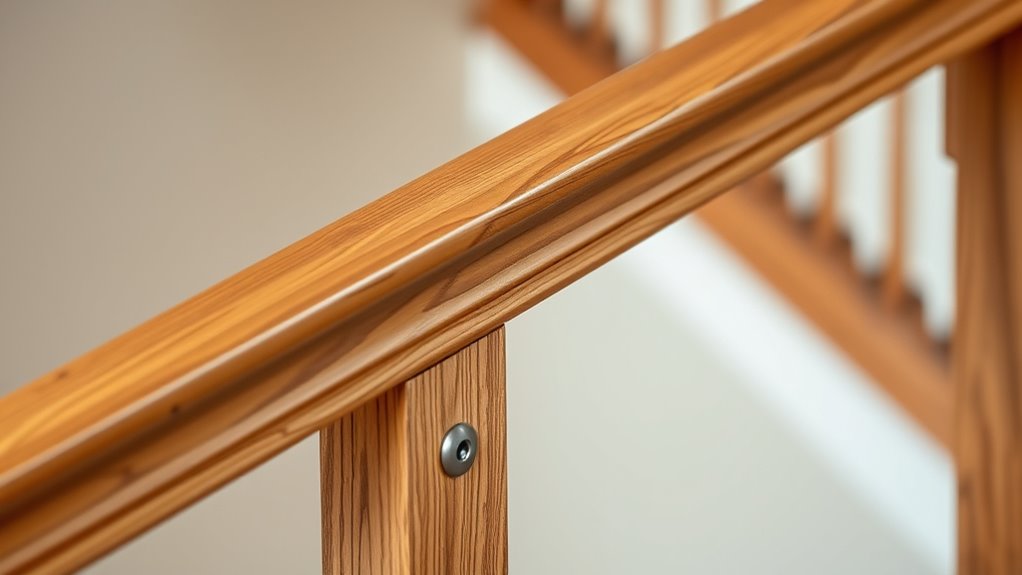
When you hire a skilled professional, you can count on precise installation that meets safety standards. Their expertise also guarantees the handrail will last longer and withstand daily wear. Ultimately, investing in a pro saves you time and reduces the risk of costly mistakes. Additionally, a professional can ensure the handrail complies with building codes and safety regulations, providing peace of mind for you and your family.
Expert Installation Precision
Hiring a skilled professional guarantees your handrails are installed with unmatched precision and safety. They ensure proper alignment, secure mounting, and adherence to building codes, reducing risks. When it comes to decorative finishes and aesthetic considerations, a pro’s expertise makes a significant difference. They can perfectly match styles, choose complementary materials, and create a seamless look that enhances your space. Proper project management during installation ensures the process is efficient and meets all necessary standards. Consider these benefits: 1. Accurate measurements and placement for a polished appearance. 2. Expert handling of decorative finishes to match your interior design. 3. Attention to aesthetic details that elevate your home’s overall look. With a pro, you get craftsmanship that combines safety with beauty, ensuring your handrails are both functional and visually appealing.
Long-Term Durability
Because a professional guarantees that your handrails are securely anchored with quality materials and proper techniques, they are more likely to withstand the test of time. This ensures your handrail maintains its structural integrity and safety over the years. Skilled installation also preserves handrail aesthetics, whether you prefer sleek modern designs or vintage styles that add character to your space. An expert can select durable materials suited to your environment, preventing issues like warping or corrosion. Self Watering Plant Pots can provide consistent moisture for plants, reducing maintenance efforts and promoting healthy growth. DIY projects may save money initially but can lead to costly repairs or replacements down the line. Hiring a professional ensures your handrails remain attractive and functional long-term, giving you peace of mind and a lasting investment that enhances your home’s safety and charm.
Potential Risks and Common Mistakes in DIY Projects
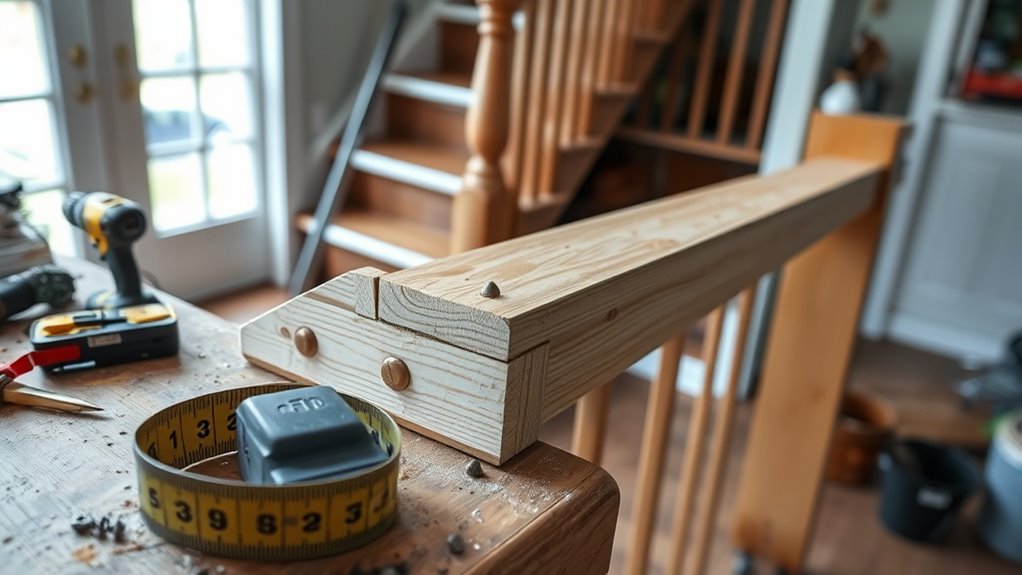
Undertaking a DIY handrail project can lead to serious risks if you’re not careful, as small mistakes can compromise safety and stability. One common mistake is rushing through material selection, which may result in weak or unsuitable materials that can fail over time. Poor attention to aesthetic design can also lead to a handrail that looks out of place or is uncomfortable to use. Additionally, mistakes in measurements or installation can cause instability. To avoid these issues, focus on:
- Choosing durable, code-compliant materials suited for your environment
- Planning an aesthetic design that blends with your space while ensuring safety
- Carefully measuring and securely installing the handrail to prevent wobbling or failure
Skipping these steps risks safety, requiring costly repairs or replacements later.
When to Consider Professional Assistance
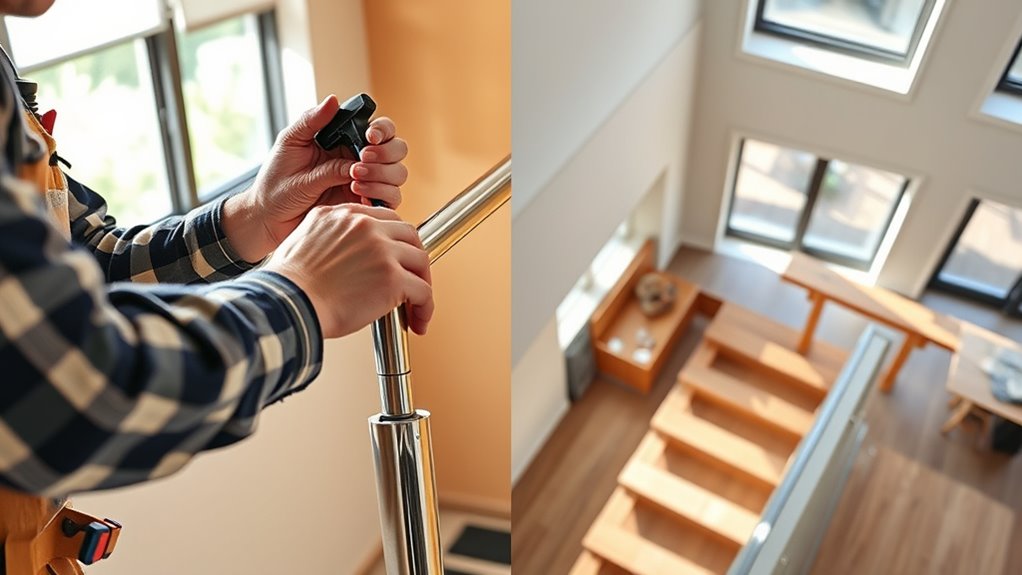
While some handrail projects are manageable as DIY tasks, there are clear signs that you should bring in a professional. If you’re unsure about design aesthetics or material selection, a pro can help ensure your handrail complements your space and meets safety standards. Additionally, if your staircase has unique angles or requires precise measurements, professional expertise prevents costly mistakes. Consider hiring a pro when your project demands structural integrity, or if local building codes require licensed installation.
| Design Aesthetics | Material Selection | Complex Installation |
|---|---|---|
| You want it to match your style | Choosing the right durability | Unusual staircase layouts |
| Consistency in look | Proper safety compliance | Ensuring stability |
| Unique finishes | Long-term wear & tear | Heightened safety needs |
| Visual harmony | Material compatibility | Custom fittings needed |
Tips for Ensuring a Safe and Durable Handrail Installation
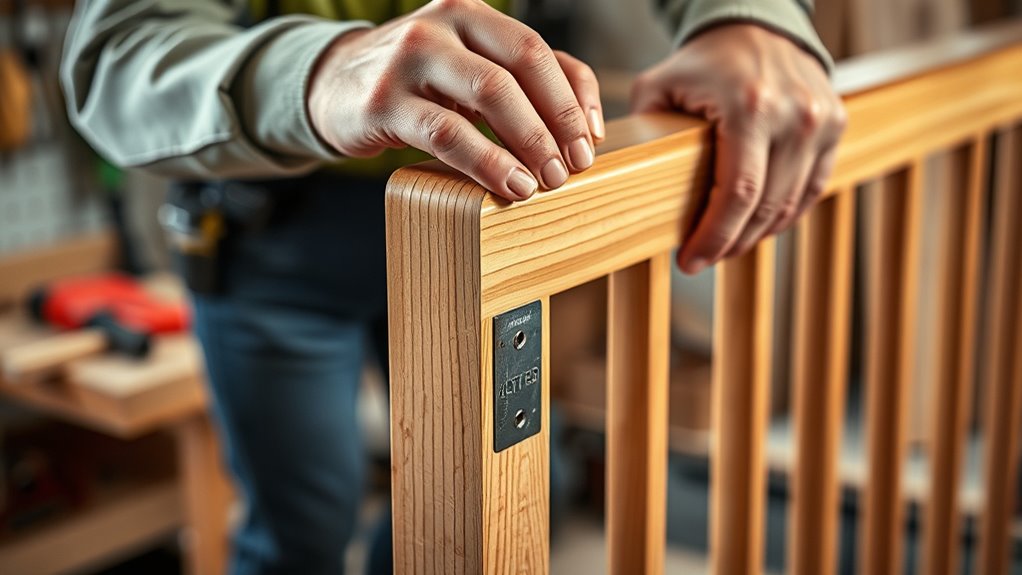
To guarantee your handrail is both safe and long-lasting, start by selecting high-quality materials that are suitable for your environment and meet safety standards. Focus on design aesthetics to ensure your handrail complements your space. To enhance durability and safety, consider these tips:
Choose durable, eco-friendly materials and ensure secure installation for a safe, long-lasting handrail.
- Use corrosion-resistant materials like stainless steel or treated wood.
- Ensure proper anchoring and secure mounting to support weight and prevent accidents.
- Balance environmental impact with longevity by choosing eco-friendly options that don’t compromise durability.
Frequently Asked Questions
How Long Does a Typical Handrail Installation Take?
The installation timeline for a typical handrail varies based on complexity and your experience. If you’re doing it yourself, expect the project duration to be around a few hours to a day, depending on the scope. Hiring a professional can accelerate the process, often completing it within a few hours. Planning your project carefully helps guarantee a smooth process and accurate timeline, whether DIY or professional.
Can I Install a Handrail Without Any Prior Experience?
You can install a handrail without prior experience, but safety concerns are essential. If you’re comfortable with basic tools and follow proper instructions, it’s possible. However, you’ll need specific tool requirements like a drill, level, and measuring tape. Keep in mind, incorrect installation can lead to accidents, so if you’re unsure, hiring a professional guarantees safety and proper fit, especially for vital support areas.
What Are the Most Common Mistakes in DIY Handrail Projects?
Did you know that 60% of DIY projects face safety hazards due to common mistakes? When installing a handrail, you might slip up with material selection, choosing something too weak or unsuitable, risking safety. The biggest mistakes include improper measurement, poor attachment, and ignoring local codes. These errors compromise stability and safety, so double-check measurements and secure everything properly, especially if you’re new to DIY projects.
How Do I Choose the Best Material for My Handrail?
When choosing the best material for your handrail, consider material durability and style options. You want something sturdy that withstands daily use, like hardwood or metal, while matching your home’s aesthetic. Think about your environment—outdoor or indoor—and select a material that resists weather or wear. Your choice should blend functionality with style, ensuring safety and enhancing your space’s look.
Are There Any Warranties or Guarantees for DIY Versus Professional Work?
When considering warranties or guarantees, DIY work usually lacks warranty coverage and a workmanship guarantee, meaning you’re responsible if issues arise. Professional work often includes warranties that cover materials and craftsmanship, giving you peace of mind. Hiring a pro ensures you get warranty coverage and a workmanship guarantee, protecting your investment. With DIY, you’re taking on the risk, but professionals back their work with guarantees that can save you money long-term.
Conclusion
Deciding whether to DIY or hire a pro depends on your skill level and project complexity. Did you know that improper handrail installation accounts for nearly 20% of stair-related injuries? Ensuring safety and compliance is essential, so if you’re unsure, it’s best to bring in a professional. Investing in expert help can prevent costly mistakes and provide lasting durability. Ultimately, prioritizing safety and quality guarantees peace of mind for you and your loved ones.
